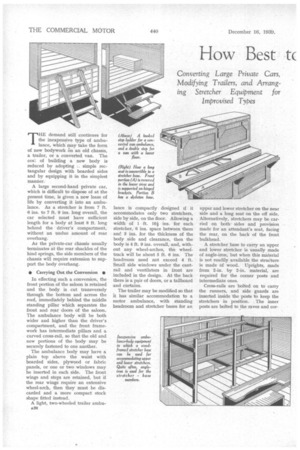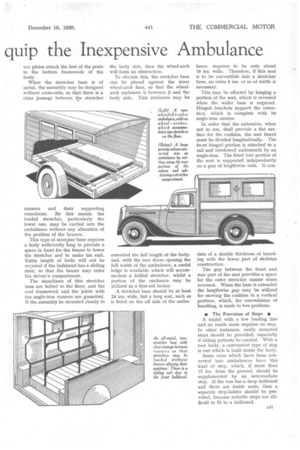How Best tc
Page 32

Page 33

If you've noticed an error in this article please click here to report it so we can fix it.
quip the Inexpensive Ambulance
THE demand still continues for the inexpensive type of ambulance, which may take the form of new bodywork On an old chassis, a trailer, or a converted van. The ocs'.: of building a new body is reduced by adopting .. simple rectangular design with boarded sides and by equipping it in the simplest manner.
A large second-hand private car, which is difficult to dispose of at the present time, is given a new lease of life by converting it into an ambulance. As a stretcher is from 7 ft. 6 ins. to 7 ft. 9 ins, long overall, the car selected must have sufficient length for a body at least 8 ft. long behind the driver's compartment, without an undue amount of rear overhang.
As the private-car Chassis usually terminates at the rear shackles of the hind springs, the side members of the chassis will require extension to support the body overhang.
• Carrying Out the Conversion • In effecting such a conversion, the front portion of the saloon is retained and the body is cut transversely through the bottom and across the roof, immediately behind the middle standing pillar which separates the front and rear doors of the saloon. The ambulance body will be both wider and higher than the driver's compartment, and the front framework has intermediate pillars and a curved cross-rail, so that the old and new portions of the body may be securely fastened to one another.
The ambulance body may have a plain top above the waist with boarded sides, plywood or fabric panels, or one or two windows may be inserted in each side. The front wings and steps are retained, but if the rear wings require an extensive wheel-arch, then they must be discarded and a more compact stock shape fitted instead.
A light, two-wheeled trailer ambuA30
lance is compactly designed if it accommodates only two stretchers, side by side, on the floor. Allowing a width of 1 ft. 104 ins, for each stretcher, 6 ins, space between them and 3 ins, for the thickness of the body side and clearance, then the body is 4 ft. 9 ins, overall, and, without any wheel-arches, the wheeltrack will be about 5 ft. 6 ins. The headroom .need not exceed 4 ft. Small side windows under the cantrail and ventilators in front are included in the design. At the back there is a pair of doors, or a tailboard and curtains.
The trailer may be modified so that it has similar accommodation to a motor ambulance, with standing headroom and stretcher bases for an upper and lower stretcher on the near side and a long seat on the off side. Alternatively, stretchers may be carried on both sides and provision made for an attendant's seat, facing the rear, on the back of the front bulkhead.
A stretcher base to carry an upper and lower stretcher is usually made of angle-iron, but when this material is not readily available the structure is made of wood. Uprights, made from 2-in. by 2-in, material, are required for the corner posts and intermediate ones.
Cross-rails are bolted on to carry the runners, and side guards are inserted inside the posts to keep the stretchers in position. The inner posts are bolted to the raves and cor nor plates attach the feet of the posts to the bottom framework of the body.
When the stretcher base is of metal, the assembly may be designed without cross-rails, so that there is a clear passage between the stretcher runners and their supporting stanchions. By this means, the loaded stretcher, particularly the lower one, may be carried into the ambulance without any alteration of the position of the bearers.
This type of stretcher base requires a body sufficiently song to provide a space in front for the bearer to lower the stretcher and to make his exit. Extra length of body will not be required if the bulkhead ha.s a sliding door, so that the bearer may enter the driver's compartment.
The stanchions of this stretcher base are bolted to the floor, and the roof framework and the joints with the angle-iron runners are gussetted. If the assembly be mounted closely to the body side, then the wheel-arch will form an obstruction.
To obviate this, the stretcher base can be placed against the inner wheel-arch face, so that the wheelarch enclosure is between it and the body side. This enclosure may be extended the full length of the body, and, with the rear doors opening the full width of the ambulance, a useful ledge is available which will accommcdate a folded stretcher, whilst a portion of the enclosure may be utilized as a first-aid locker.
A stretcher base should be at least 24 ins, wide, but a long seat, such as is fitted on the off side of the ambu
lance, requires to be only about 18 ins. wide. Therefore, if this seat is to be convertible into a stretcher base, an extra 6 ins. or so of width is necessary.
This may be effected by hinging a portion of the seat, which is reversed when the wider base is required. Hinged ..brackets support. the extensicn, which is complete with its angle-iron runner.
In order that the extension, when not in use, shall provide a flat surface for the -cushion, the seat board must be divided longitudinally. The frcnt hinged portion is attached to a rail and reinforced underneath by an angle-iron. The fixed rear portion of the seat is supported independently on a pair of lengthwise rails. It con
sists of a double thickness of boarding with the lower part of skeleton construction.
The gap between the front and rear part of the seat provides a space for the outer stretcher runner when reversed. When the base is extended the lengthwise gap may be utilized for stowing the cushion in a vertical position, which, for convenience of handling, is made in two portions.
• The Provision of Steps • A trailei with a low loading line and no inside seats requires no step. In other instances, easily mounted steps should be provided, especially if sitting patients be carried. With a new body, a convenient type of step is one which is built inside the body.
Some vans which have been converted into ambulances have this kind of step, which, if more than 12 ins, from the ground, should be supplemented by an intermediate step. If the van has a deep tailboard and there are inside seats, then a separate step-ladder should be provided, because suitable steps are difficult to fit to a tailboard.




































































